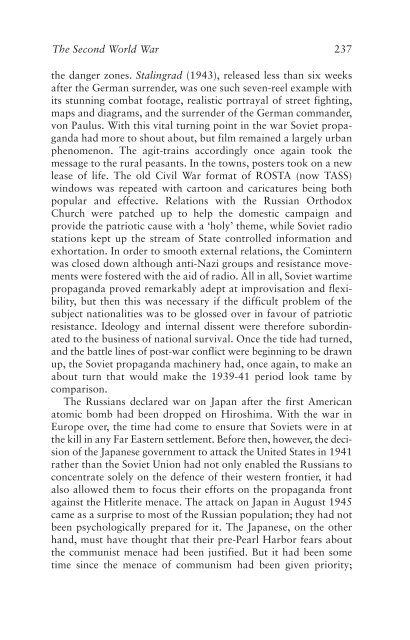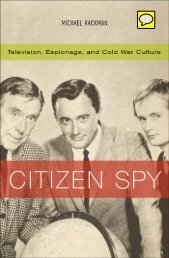- Page 1 and 2:
Third edition Munitions of the mind
- Page 3 and 4:
For Professor Nicholas Pronay
- Page 5 and 6:
Copyright © Philip M. Taylor 1990,
- Page 7 and 8:
vi Contents Part Four Propaganda in
- Page 9 and 10:
Preface to the New Edition This boo
- Page 11 and 12:
2 Introduction bear false witness,
- Page 13 and 14:
4 Introduction The reason for this
- Page 15 and 16:
6 Introduction telling us ‘the tr
- Page 17 and 18:
8 Introduction when all these issue
- Page 19 and 20:
10 Introduction warfare through the
- Page 21 and 22:
12 Introduction as experienced by t
- Page 23 and 24:
14 Introduction The difference, of
- Page 25 and 26:
16 Introduction Over the expanse of
- Page 28 and 29:
Chapter 1 In the Beginning … We s
- Page 30 and 31:
In the Beginning … 21 writing kno
- Page 32 and 33:
In the Beginning … 23 By the firs
- Page 34 and 35:
Chapter 2 Ancient Greece In Greece,
- Page 36 and 37:
Ancient Greece 27 was indulging in
- Page 38 and 39:
Ancient Greece 29 Greeks) who were
- Page 40 and 41:
Ancient Greece 31 greater numbers t
- Page 42 and 43:
Ancient Greece 33 Philip was assass
- Page 44 and 45:
Chapter 3 The Glory that was Rome R
- Page 46 and 47:
The Glory that was Rome 37 refraini
- Page 48 and 49:
The Glory that was Rome 39 ‘the g
- Page 50 and 51:
The Glory that was Rome 41 Roman wa
- Page 52 and 53:
The Glory that was Rome 43 ‘may s
- Page 54 and 55:
The Glory that was Rome 45 secured,
- Page 56 and 57:
The Glory that was Rome 47 major co
- Page 58:
Part Two Propaganda in the Middle A
- Page 61 and 62:
52 Propaganda in the Middle Ages he
- Page 63 and 64:
54 Propaganda in the Middle Ages is
- Page 65 and 66:
56 Propaganda in the Middle Ages Lo
- Page 67 and 68:
58 Propaganda in the Middle Ages (7
- Page 69 and 70:
60 Propaganda in the Middle Ages Ch
- Page 71 and 72:
Chapter 5 The Norman Conquest For t
- Page 73 and 74:
64 Propaganda in the Middle Ages De
- Page 75 and 76:
66 Propaganda in the Middle Ages Ha
- Page 77 and 78:
68 Propaganda in the Middle Ages fa
- Page 79 and 80:
70 Propaganda in the Middle Ages sh
- Page 81 and 82:
72 Propaganda in the Middle Ages id
- Page 83 and 84:
74 Propaganda in the Middle Ages an
- Page 85 and 86:
76 Propaganda in the Middle Ages co
- Page 87 and 88:
78 Propaganda in the Middle Ages An
- Page 89 and 90:
80 Propaganda in the Middle Ages co
- Page 91 and 92:
82 Propaganda in the Middle Ages es
- Page 93 and 94:
84 Propaganda in the Middle Ages of
- Page 96 and 97:
Chapter 9 The Gutenberg Galaxy No h
- Page 98 and 99:
Chapter 10 Renaissance Warfare The
- Page 100 and 101:
Renaissance Warfare 91 When the Fre
- Page 102 and 103:
Renaissance Warfare 93 longer comma
- Page 104 and 105:
Renaissance Warfare 95 also saw the
- Page 106 and 107:
Chapter 11 The Reformation and the
- Page 108 and 109:
The Reformation and the War of Reli
- Page 110 and 111:
The Reformation and the War of Reli
- Page 112 and 113:
Tudor Propaganda 103 The wealth and
- Page 114 and 115:
Tudor Propaganda 105 whose industry
- Page 116 and 117:
Tudor Propaganda 107 caused his pol
- Page 118 and 119:
Chapter 13 The Thirty Years War (16
- Page 120 and 121:
The Thirty Years War 111 Catholics
- Page 122 and 123:
The Thirty Years War 113 men before
- Page 124 and 125:
The Thirty Years War 115 Attempts a
- Page 126 and 127:
Chapter 14 The English Civil War (1
- Page 128 and 129:
The English Civil War 119 who manag
- Page 130 and 131:
Chapter 15 Louis XIV (1661-1715) If
- Page 132 and 133:
Louis XIV 123 Mazarin attempted to
- Page 134 and 135:
Louis XIV 125 at people who were no
- Page 136:
Part Four Propaganda in the Age of
- Page 139 and 140:
130 Propaganda in the Age of Revolu
- Page 141 and 142:
132 Propaganda in the Age of Revolu
- Page 143 and 144:
134 Propaganda in the Age of Revolu
- Page 145 and 146:
136 Propaganda in the Age of Revolu
- Page 147 and 148:
138 Propaganda in the Age of Revolu
- Page 149 and 150:
140 Propaganda in the Age of Revolu
- Page 151 and 152:
142 Propaganda in the Age of Revolu
- Page 153 and 154:
144 Propaganda in the Age of Revolu
- Page 155 and 156:
146 Propaganda in the Age of Revolu
- Page 157 and 158:
148 Propaganda in the Age of Revolu
- Page 159 and 160:
150 Propaganda in the Age of Revolu
- Page 161 and 162:
152 Propaganda in the Age of Revolu
- Page 163 and 164:
154 Propaganda in the Age of Revolu
- Page 165 and 166:
156 Propaganda in the Age of Revolu
- Page 167 and 168:
Chapter 19 War and Public Opinion i
- Page 169 and 170:
160 Propaganda in the Age of Revolu
- Page 171 and 172:
162 Propaganda in the Age of Revolu
- Page 173 and 174:
164 Propaganda in the Age of Revolu
- Page 175 and 176:
166 Propaganda in the Age of Revolu
- Page 177 and 178:
168 Propaganda in the Age of Revolu
- Page 179 and 180:
170 Propaganda in the Age of Revolu
- Page 182 and 183:
Chapter 20 War and the Communicatio
- Page 184 and 185:
War and the Communications Revoluti
- Page 186 and 187:
The First World War 177 battle betw
- Page 188 and 189:
The First World War 179 published i
- Page 190 and 191:
The First World War 181 press who h
- Page 192 and 193:
The First World War 183 fought and
- Page 194 and 195:
The First World War 185 Raemakers,
- Page 196 and 197: The First World War 187 The Creel C
- Page 198 and 199: The First World War 189 from London
- Page 200 and 201: The First World War 191 morale, wit
- Page 202 and 203: The First World War 193 impact on t
- Page 204 and 205: The First World War 195 The wartime
- Page 206 and 207: The First World War 197 the destruc
- Page 208 and 209: The Bolshevik Revolution and the Wa
- Page 210 and 211: The Bolshevik Revolution and the Wa
- Page 212 and 213: The Bolshevik Revolution and the Wa
- Page 214 and 215: The Bolshevik Revolution and the Wa
- Page 216 and 217: The Bolshevik Revolution and the Wa
- Page 218 and 219: The Second World War 209 for the pr
- Page 220 and 221: The Second World War 211 Christmas.
- Page 222 and 223: The Second World War 213 effective.
- Page 224 and 225: The Second World War 215 the Englis
- Page 226 and 227: The Second World War 217 posters, s
- Page 228 and 229: The Second World War 219 in tone an
- Page 230 and 231: The Second World War 221 In a serie
- Page 232 and 233: The Second World War 223 credibilit
- Page 234 and 235: The Second World War 225 had it not
- Page 236 and 237: The Second World War 227 invention
- Page 238 and 239: The Second World War 229 also refle
- Page 240 and 241: The Second World War 231 stray into
- Page 242 and 243: The Second World War 233 criminals
- Page 244 and 245: The Second World War 235 Germany wi
- Page 248 and 249: The Second World War 239 throughout
- Page 250 and 251: The Second World War 241 subjected
- Page 252 and 253: The Second World War 243 managed ev
- Page 254 and 255: The Second World War 245 the realit
- Page 256 and 257: The Second World War 247 were not a
- Page 258 and 259: Chapter 24 Propaganda, Cold War and
- Page 260 and 261: Propaganda, Cold War and the Televi
- Page 262 and 263: Propaganda, Cold War and the Televi
- Page 264 and 265: Propaganda, Cold War and the Televi
- Page 266 and 267: Propaganda, Cold War and the Televi
- Page 268 and 269: Propaganda, Cold War and the Televi
- Page 270 and 271: Propaganda, Cold War and the Televi
- Page 272 and 273: Propaganda, Cold War and the Televi
- Page 274 and 275: Propaganda, Cold War and the Televi
- Page 276 and 277: Propaganda, Cold War and the Televi
- Page 278 and 279: Propaganda, Cold War and the Televi
- Page 280 and 281: Propaganda, Cold War and the Televi
- Page 282 and 283: Propaganda, Cold War and the Televi
- Page 284 and 285: Propaganda, Cold War and the Televi
- Page 286 and 287: Propaganda, Cold War and the Televi
- Page 288 and 289: Propaganda, Cold War and the Televi
- Page 290 and 291: Propaganda, Cold War and the Televi
- Page 292 and 293: The Gulf War of 1991 283 Part Six T
- Page 294 and 295: The Gulf War of 1991 285 Chapter 25
- Page 296 and 297:
The Gulf War of 1991 287 Hopes that
- Page 298 and 299:
The Gulf War of 1991 289 watching a
- Page 300 and 301:
The Gulf War of 1991 291 happening,
- Page 302 and 303:
The Gulf War of 1991 293 pundits gu
- Page 304 and 305:
The Gulf War of 1991 295 system had
- Page 306 and 307:
The Gulf War of 1991 297 Radio tran
- Page 308 and 309:
Information-Age Conflict in the Pos
- Page 310 and 311:
Information-Age Conflict in the Pos
- Page 312 and 313:
Information-Age Conflict in the Pos
- Page 314 and 315:
Information-Age Conflict in the Pos
- Page 316 and 317:
Information-Age Conflict in the Pos
- Page 318 and 319:
Information-Age Conflict in the Pos
- Page 320 and 321:
Information-Age Conflict in the Pos
- Page 322 and 323:
Information-Age Conflict in the Pos
- Page 324 and 325:
The World after 11 September 2001 3
- Page 326 and 327:
The World after 11 September 2001 3
- Page 328 and 329:
The World after 11 September 2001 3
- Page 330 and 331:
Epilogue 321 on that theory, we exp
- Page 332 and 333:
Epilogue 323 practices as they oper
- Page 334 and 335:
Bibliographical Essay 325 Chapter 2
- Page 336 and 337:
Bibliographical Essay 327 Brundage
- Page 338 and 339:
Bibliographical Essay 329 Propagand
- Page 340 and 341:
Bibliographical Essay 331 Holmes’
- Page 342 and 343:
Index 333 atrocity propaganda, 3, 7
- Page 344 and 345:
Index 335 Cromwell, Oliver, 119-20,
- Page 346 and 347:
Index 337 Guibert of Nogent, 74 Gul
- Page 348 and 349:
Index 339 Macauley, Lord, 132 Maced
- Page 350 and 351:
Index 341 Press Association, 213 Pr
- Page 352 and 353:
Index 343 Tolbic, battle of, 55 Tor



